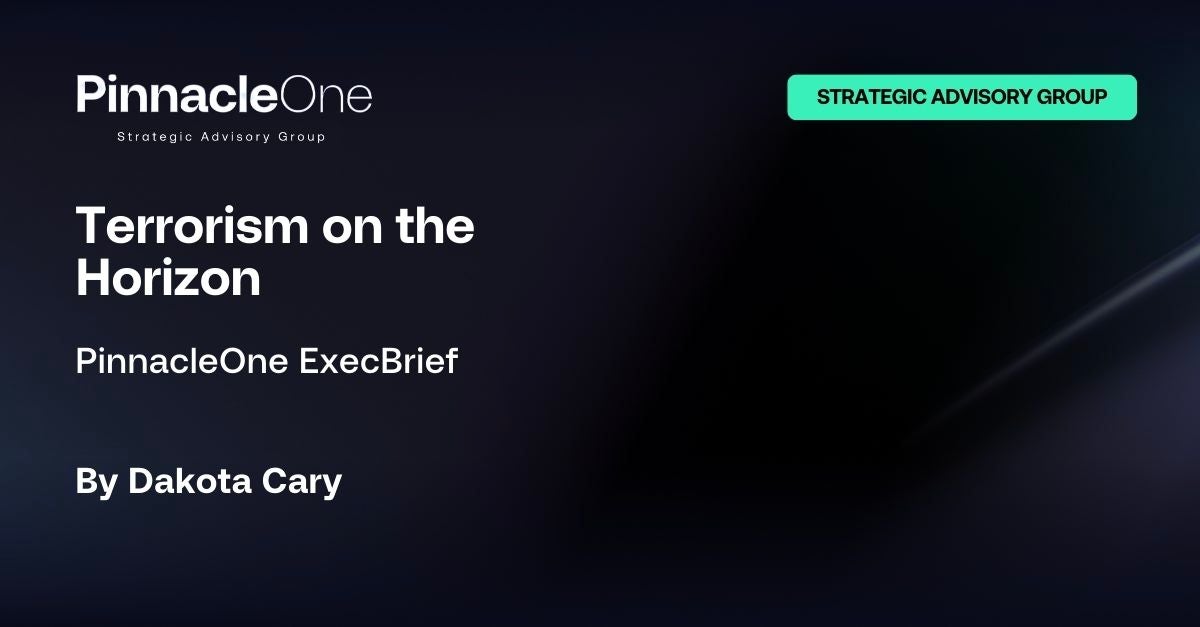Last week, we highlighted how nation-state sabotage risked critical infrastructure and operations for modern enterprises. This week, we note the recent spate of terrorist attacks and increasing alarm from governments around the world.
Please subscribe to read future issues — and forward this newsletter to interested colleagues.
Contact us directly with any comments or questions: [email protected]

PinnacleOne ExecBrief | Terrorism on the Horizon
The year started with a twin-bombing hit in Tehran. At an event marking the anniversary of the U.S.’s assassination of the commander of Iran’s clandestine and special forces unit, two bombs went off in succession, killing more than 200 mourners. The Islamic State (ISIS, Daesh, and ISI-L) claimed responsibility for the attack.
U.S. Central Command, the military theater command responsible for central asia, issued a statement on July 16th warning that ISIS was reconstituting in Syria and Iraq. Less than 24 hours before the attack, ISIS gunmen killed 6 and injured 28 in a terror attack at a mosque in Oman. The warning came not from predictive intelligence of an impending attack, but from backwards looking analysis. According to CENTCOM, ISIS is on-track to double its total number of attacks it launched in 2023.
The situation is actually worse than CENTCOM reported, however. According to experts, CENTCOM statistics only reflect the attacks claimed by ISIS. Data and analysis from the Middle East Institute, a think-tank in Washington, suggests the total number of ISIS attacks in Iraq and Syria are between 3-5 times higher than what CENTCOM announced.
Evidence of the group’s momentum is building. On Monday of last week, Australia’s government elevated its National Terrorism Threat Level to “probable.” By Wednesday, Taylor Swift canceled three concerts in Vienna following the arrest of men who admitted to planning an attack on the event. The would-be assailants pledged loyalty to ISIS.
The successful interdiction of the Vienna attackers is not cause for anything more than quick relief. Unfortunately, the trendline is towards a greater frequency of attacks abroad by ISIS.
How Things Can Change
Although U.S. forces are stationed in both Iraq and Syria, the international coalition that squashed ISIS in the late 2010s is not nearly as vociferous as it was. The lack of focus is not just in the Middle East. France has reduced its footprint in the Sahel, leaving much of northern Africa open to increasing jihadism. In addition to multilateral forces leaving the continent, Africans are overthrowing their governments in the 2020s at a rate not seen since the 1990s. Violence by ISIS and Al-Qaeda is at all-time highs in the continent, surpassing 10,000 deaths each year. This successful franchising of ISIS across continents raises the bar for coordination even higher than just the Middle East alone.
If conflict escalates between Iran and its proxies and Israel, then events on the ground may incentivize ISIS commanders to focus on their near-term geographic gains in Iraq and Syria. If it were to occur, any international coalition would be further spent by their likely involvement or focus on the conflict, risking more success further down the road for ISIS. Facts on the ground could easily move against ISIS, however, as operations against Iranian proxies in Syria could easily also serve dual-purpose for strikes against ISIS. Still, this looks unlikely.
Across the rich world, appetite for intervention abroad – even as prevention for attacks at home – has waned. It will likely take a few successful attacks to change priorities in capitals across Europe and the U.S. In a federal election year in the U.S., successful attacks could swiftly alter the political landscape in unforeseeable ways. With its own issues of political violence to confront, the U.S. law enforcement community already has its hands full. Expect a few successful terror attacks over the next three years before things improve.


